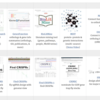CRISPR genome editing
2023
Feb
24
2023
Feb
17
. 2022. “State-of-the-art CRISPR for in vivo and cell-based studies in Drosophila.” Trends Genet, 38, 5, Pp. 437-453.Abstract
. 2022. “Prime Editing for Precise Genome Engineering in Drosophila.” In Drosophila: Methods and Protocols, , Pp. 113 - 134. New York, NY: Springer US. Publisher's VersionAbstract
Read the DRSC/TRiP Report to the Fly Board 2022
. 11/24/2021. “Bioinformatic and cell-based tools for pooled CRISPR knockout screening in mosquitos.” Nat Commun, 12, 1, Pp. 6825.Abstract
DRSC/TRiP and DRSC-BTRR Office Hours
. 2021. “Optimized CRISPR tools and site-directed transgenesis towards gene drive development in Culex quinquefasciatus mosquitoes.” Nat Commun, 12, 1, Pp. 2960.Abstract
. 11/1/2020. “CRISPR-Cas13 mediated Knock Down in Drosophila cultured cells.” BioRxiv.Abstract
. 2021. “Precise genome engineering in Drosophila using prime editing.” Proc Natl Acad Sci U S A, 118.Abstract
New publications from the DRSC bioinformatics team
. 2020. “FlyRNAi.org-the database of the Drosophila RNAi screening center and transgenic RNAi project: 2021 update.” Nucleic Acids Res.Abstract
2020
Sep
21



